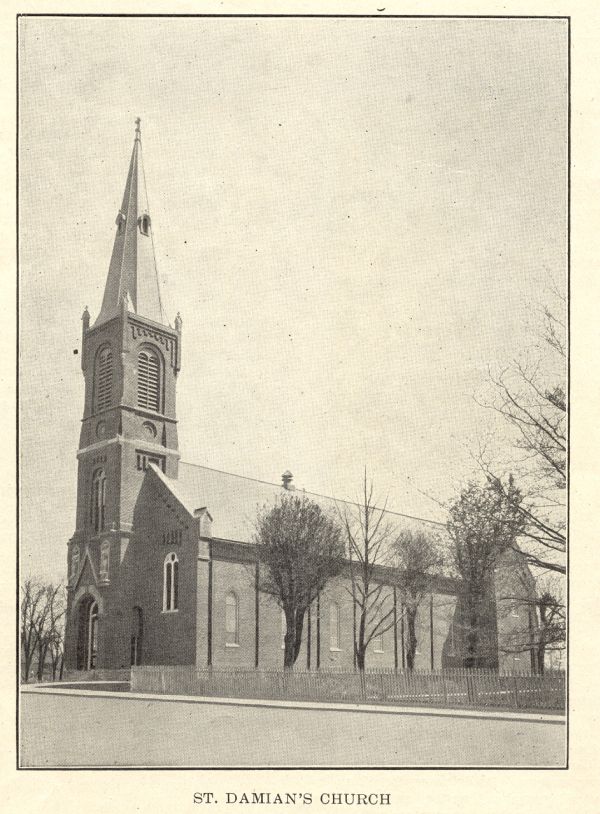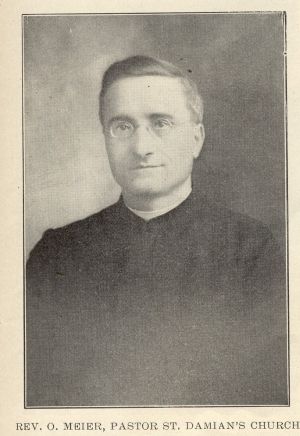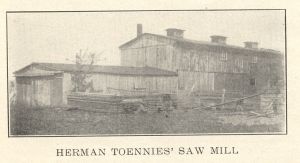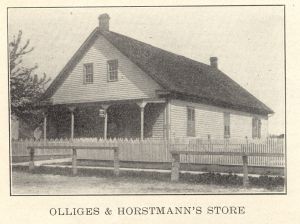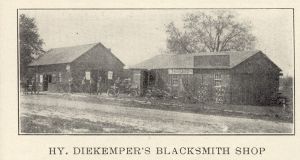|
Page 40 |
|
|
Damiansville, named in honor of Bishop Damian JUNKER of Alton, is located five miles northeast of Memphis and two miles south of Albers in Clinton County. It is an inland town and has a population of approximately 150 inhabitants. Its large and beautiful Catholic church |
of the Catholic belt, which extends north and south from St. Rose to Damiansville, and east and west from Bartelso and Carlyle to Mascoutah and Trenton. The residents of this entire district are principally of German parentage, very few families of other nationality living within the district thus formed. |
|
|
|
|
an its parochial school are the principal monuments of progress in this little village. The entire citizenship is Catholic, and this not to be wondered at when one realizes that Damiansville lies right in the heart |
Damiansville is one of the oldest villages in the county. As early as 1861 Henry HAIDDERS erected a store building in which he put a small stock of goods. The third house was built the same year by B. STEPHENS who opened a |
|
Page 41 |
|
|
store here. A postoffice was established in 1862. This pretty little village has not grown perceptibly during the past fifty years, but it presents an ideal picture of rural happiness and simplicity. Its citizens are of a high degree of intelligence and possessed of great religious fervor. Damiansville has two large and well-stocked general stores, one blacksmith shop, one shoe store, one carpenter shop, one paint shop, and several smaller business concerns. St. Damian's Parish The first Catholic settlers within the territory of the present St. Damian's parish came here 1837 from Holland and Hanover, Germany, and called the settlement Dempter, which was the name of a town in their native land. Their names, like HEIMANN, SANTEL, KALMER, MIDDENDORFF, are to the present day most popular in the parish. Divine services were attended and religious duties fulfilled in Germantown, where various priests administered to the spiritual wants of the scattered Catholics of Clinton county since 1837. In the course of the following 20 years new emigrants from Germany arrived and had secured homesteads
through the encouragement and help of the first settlers. In the year 1860 the Rt. Rev. Bishop JUNKER of Alton secured 20 acres of land in the southwestern part of the Clinton county known then and now as Looking Glass township, including the present towns of New Baden and Albers. This territory was to form a parish with a church to be built on the above mentioned land and centrally located for the 50 Catholic families of the neighborhood. Church and parish were placed under the patronage of St. Damian in grateful remembrance of its founder, the |
Rt. Rev. Bishop of Alton, whose name was Damian, and the postoffice was erected under the name of Damiansville. The Rev. A. BERGER was named the first pastor of the newly erected parish and said the first mass in the unfinished church February 2, 1861. In April, 1864, Rev. F. SCHMLIZECK succeeded Father BERGER, and in November, 1868, Rev. J. LOHMANN took charge of St. Damian's congregation to stay to the date of his death July 27, 1903. Rev. O. MEIER, the present rector, and received his appointment a few days after the above date. Rev. Hy. ALTHOFF, who was the assistant to the sickly pastor for 9 months, acted as administrators of the parish till the arrival of Rev. O. MEIER. The first church erected in 1861 was solid brick structure of Roman style with a sanctuary, but without a steeple. It formed half of the present church, which is 120 feet long, 46 feet wide and is fronted by a stately tower of 130 feet height, which lodges a chime of 3 large bells. The church in its present majestic appearance was completed 1879 and is beautifully equipped inside and represents a value of $40,000. Its seating capacity is 350. The first rectory, built in 1861 aside of the church, was a one-story brick house costing about $2,000. In 1891 the present stately parsonage was erected at the cost of $9,000; built of hard brick on an extraordinary strong rock foundation and covered by a slate roof. The erection of a one-room frame school building coincides with the time of the formation of St. Damian's parish. A frame house for the teacher was built on the church property in 1865 at the cost of $1,400, which was replaced by a more modern frame structure 1904 at the cost of $1,700 and is now inhabited by 3 Sisters of the Precious Blood, who have charge of St. Damian's School since 1889. The year 1904 witnessed the erection of a better and larger school building 62 feet long and 42 feet wide, costing $6,500, and containing in the upper story an entertainment hall and in the lower story two school rooms and a meeting room for the various societies of the parish. The oldest and strongest of these societies is the Married Ladies' Altar and Christian Mother Society with a membership of 75. The St. Damian's Men and Holy Name Society counts 60 members. The St. Aloysius' Young Men's Society numbers 60 and the St. Rose's Young Ladies' Society 40 members. At present 80 families form the total strength of the parish with 485 souls. The parish enjoyed a steady and natural growth ever since its beginning, the number of 125 families being reached at one time. Through the erection of neighboring parishes a decrease was noticed at various times; thus from 1867, when a church was built at Trenton, the Catholics of the town of New Baden attended divine service there; again in 1894 the newly erected New Baden parish severed 25 families from the mother church; in 1908 25 families were assigned to the new St. Bernard's congregation at Albers. Eight religious sisters call St. Damian's parish their native home. Previous to 1861 the dead of the settlement were buried at Germantown. From 1861 to 1863 interments were made in the northwest corner of the church land bordering on the main public road of the town. In spring, 1863, this burial place was abandoned for the present site of St. Damian's cemetery, comprising two acres of land in the southwest corner of the church property. A beautiful crucifixion group adorns the center of this scared spot. Rev. Otto MEIER was born in the Catholic village of Vimbuch, Baden, Sept. 30th, 1867; he studied his classics in his native country, absolved philosophy and theology in St. Meinrad's seminary, Ind., and was ordained by the Rt. Rev. J. JANSSEN in the Cathedral of Belleville June the 13th, 1890. After a short assistantship at Millstadt and Lively Grove he was assigned to Sandoval and surrounding missions. In March, 1896, he was appointed to |
|
Page 42 |
|
|
the pastorate of Centralia, and In August, 1903, his present charge was entrusted to him. Herman TOENNIES Mr. H. TOENNIES was born in Carlyle in 1862 and is a son of Albert and Agnes TOENNIES, who have been residents of the county for upwards of fifty-four years. The parents came from Germany. Herman TOENNIES has been a resident of Damiansville for forty-seven years, and is
one of the first settlers of the village. Twenty years ago he started into the saw mill business and later added a planing mill and grist mill, all of which have been paying propositions ever since. He does custom grinding only in the grist mill, and in the saw mill department does both custom and commercial sawing. Hardwood lumber is sawed almost exclusively. The capacity of the mill will average between 1,500 and 3,000 feet daily when in operation. It is equipped with a sixty-inch circular saw, and is operated by steam. The planing mill is also operated by steam. In connection with the above business Mr. TOENNIES also handles pipes, fittings, guttering and spouting, dressed lumber etc., and he has a large business along these lines. Mr. TOENNIES is active in politics. He is the Democratic Central Committeeman for his precinct and one of the staunchest Democrats in Clinton county. Damiansville being the voting place for Albers, Mr. TOENNIES is kept busy during the election seasons, but he is ever ready to serve his party or his fellow citizens. He was married to Anna FELD twenty four years ago and has five children. OLLIGES & HORSTMANN The firm of OLLIGES and HORSTMANN have been doing business as general merchants of Damiansville for the
past two years. Mr. OLLIGES, the senior member of the firm, has been a resident of the little inland city for eleven years and his partner has lived there for two |
years. They carry a general line of merchandise. Their stock is valued at $2,500. Their annual business is very large and they are constantly increasing their sales. Mr. OLLIGES is also a carpenter and contractor and during his residence in Damiansville has built a large number of houses in the village and near-by country. He is also a sidewalk contractor, builds silos, and manufactures cement blocks, doing a large business in that line. During the year 1904 he built the commodious Sister's residence adjoining the church. Mr. Bernard OLLIGES was born in Germantown in 1873 and is the son of Henry and Mary OLLIGES, one of nine children. He was married in 1901 to Kate HAAR. Four children, three of whom are living, were the result of this happy union. These children are two girls and one boy. Mr. H.C. HORSTMANN, the junior member of the firm, has been living in Damiansville for two years and hails from Beckemeyer, where he was born, and where his parents still reside. He is married and has an elegant home. Mr. HORSTMANN is the active manager of the firm and attends to the buying and other business of the store. The store of OLLIGES and HORSTMANN is located on the north side of Main street near the Catholic church. Martin SCHOMAKER There is considerable of a story connected with the business operated by Martin SCHOMAKER. It was started in 1868 by Herman SCHOMAKER, the father of the present owner. At that time only hand-made shoes were worn
and business was very good along that line. After the death of Herman SCHOMAKER in 1894, Martin inherited the business and began to add a stock of ready-made shoes, but still continuing making custom shoes, for upward of eight years. Since then the store has been developed, and a repair department been installed. Mr. SCHOMAKER likewise occasionally makes custom shoes or boots as the demand requires. These are made in the most approved style and are superior in workmanship. The father of Martin SCHOMAKER was born in the Kingdom of Prussia, in 1829, as was also his mother. Martin's mother died after a few years, and his father again married. Three children sprang from the first marriage, and eight from the second marriage. Of these eleven children nine are still living. Martin SCHOMAKER was married in 1895 to Theresa BROCKHOFF of Damiansville, who was born in this village in 1872, and is a daughter of Henry and Anna BROCKHOFF. She is one of a family of eight children. The family of Martin SCHOMAKER now consists of his wife and four children, three boys and one girl. Three children died in infancy. The oldest of the living children is sixteen years, a sturdy lad, while the youngest is a winsome little miss two years of age. |
|
Page 43 |
|
|
Henry DIEKEMPER Mr. Henry DIEKEMPER has been engaged in the blacksmith business in Damiansville for the past two years, having succeeded his father, Frank DIEKEMMPER. He is the son of Frank and Margaretha DIEKEMPER, who were natives of St. Libory, Illinois, the father being born in that village in 1857 and the mother in 1861. He is one of ten children, nine of whom are living. Previous to taking over his father's business he worked for him for upward of fourteen years, frequently working after school hours. His education was received in the Catholic school of Damiansville. Mr. DIEKEMPER does a general blacksmith business, horse shoeing, wood-working, and is considered an expert wheelwright. He also carries a line of implements, including the John Deere farm machinery, the Gestring wagons, the Banner buggies and the Johnston harvester machines and binders. He also sells gasoline engines
and supplies. His place of business is located on the north side of Main Street, west of the church. He is one of the progressive business men of this little village and is on a fair way to establish one of the most thriving businesses in that part of the county. Mr. DIEKEMPER was in 1911 married to Josephina FUEHNE. One child has blest this union. The young couple are highly esteemed by all who are acquainted with them and they number their friends by the score. DO YOU UNDERSTAND THE REAL VALUE OF PRAIRIE SCENERY. Certainly you do not, if you think man has wholly spoiled the prairie. It is easy to hold that opinion, especially after reading that charming essay by Quayle, called "The Prairie and the Sea." He mourns the wildness that is gone, but we can recreate a sample of it in a "prairie reservation." The wolves and the fires are gone, and we are glad of it. But the big features are still here - the infinite breath, the amazing fertility of the soil, and the great horizontal lines of land, wood, crops, herds and clouds. How these new middle western artists glory in these horizontal lines. Only ten years ago people thought that everything horizontal must be flat, monotonous, uninteresting. Now you can feel those glorious lines in the paintings of Peyrant and Browner, the prose of Hamlin Garland, the verse of Nicholas Lindsey and Walt Mason, the music of Orne Oldberg, and the sculpture of Lorado Taft. And our landscape gardeners, like Simonds and Jensen, plant thousands of hawthorns and crab apples, so that their horizontal lines may repeat in miniature the magnificent lines of the prairie. One of the most beautiful pictures in the world is a certain flat portion of Bucks County, Pa., with its great checkerboard of green fields varied by curving roads and lined with Pennsylvania trees and shrubs. The atmosphere is one of peace, and plenty; the homes are old and permanent, and built in a style peculiar to that part if Pennsylvania. Is it any wonder that Bucks county claimed to be the wealthiest county in the United States? But |
contrast this with the county in Illinois which now claims to be the wealthiest county in the Union. The roads are mudy enough to kill a horse, and there is not a single tree or shrub in sight along the roads. There is nothing to see along the highway; every shrub and flower has been cut down. There is nothing to soften or relieve the cast iron system that laid out the country in absolute, unvarying squares. The crops are rich but the homes are poor, temporary, citified, and of no style that is recognized by architecture. How can this be improved right off and at the least expense? "If we could have," says Dean Davenport, "A propaganda for planting our roadsides with ornamental and with useful trees, interspersed here and there with groups of hardy shrubbery, it would do more than any other single factor to make our country beautiful." In other words, the most important scenery in the world is roadside scenery, because it affects the most people. And, we are not like Colorado or other mountainous states, which have scenery on every roadside laid down by nature without cost; we must create our Illinois scenery. We have three great places in which to do it - our waterways, railways and roads. The waterways are already wooded, and the railway scenery we cannot control as yet, so our great opportunity is with the roads. Two and one-half per cent of our state's area is in roads, and if we can have these planted in the "Illinois Way," we shall have the greatest state park system in the world without the cost of buying the land. Think of a people's park containing 1,950 square miles-bigger than the while state of Rhode Island. Pennsylvania can boast of her Pennsylvania maple, Wisconsin of her willow, Iowa of her crab apple, Minnesota of her honeysuckle, and Illinois is the home of one of the loveliest shrubs in the whole world - the prairie rose (Rosa Setigera). Every day in the year it is a never ending joy. In June its large, single flowers are a poem in pink. Throughout the year its arching stems and healthy foliage fill the eye with quiet joy. And in winter its brilliant red stems are a warm and comforting sight against the snow. LET US MAKE THE ROADSIDE AN ASYLUM FOR PRAIRIE FLOWERS. What finer wild flowers are there in the world than those which once grew by the million on the prairies of Illinois - the compas plant, immortalized by Longfellow as the guide of the first explorers, the brown-eyed Susan, the sunflowers, annual and perennial, the blazing star, the Turk's cap, the western red lily, and a host of other flowers that used to glorify the prairie as far as the eye could see? In no other state, probably, have the wild Bowers been pushed so close to extermination, for no other state has so large a proportion of land suitable for cultivation. The result is that the sun-loving prairie flowers have only one city of refuge, the railways, and even there they are being destroyed by fires and choked by cosmopolitan weeds - the tramps from European roadsides. Why not restore the prairie flowers to our roadsides? It may not be wise to plant a mile with any one kind of a flower. These perennials cost too much for that. But we can plant big colonies here and there between the groups of shrubbery. In other words, the prairie flowers should be used as "fillers," and in this way they will multiply enormously, hold their own against intruding weeds, and fill every foot of roadside in the State with beauty. The prairie flowers will come back if we only give them a chance. We mow and pasture them to death. So rare are they that one of the best nurserymen in the State says that he has not seen the shooting star since he was a child and he has never seen the prairie rose growing wild in Illinois. The average value per bushel of the oat crop was $0.41 in 1909, as compared with $0.23 in 1899, an advance of 75.3 per cent. |
This file last modified
